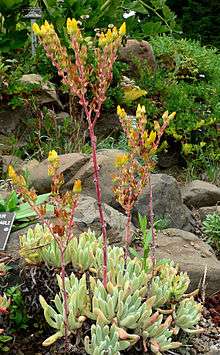Dudleya caespitosa
| Dudleya caespitosa | |
|---|---|
 | |
| Scientific classification | |
| Kingdom: | Plantae |
| (unranked): | Angiosperms |
| (unranked): | Eudicots |
| (unranked): | Core eudicots |
| Order: | Saxifragales |
| Family: | Crassulaceae |
| Genus: | Dudleya |
| Species: | D. caespitosa |
| Binomial name | |
| Dudleya caespitosa (Haw.) Britt. & Rose | |
| Synonyms[1] | |
| |
Dudleya caespitosa is a succulent plant known by several common names, including Sealettuce, Sand lettuce, and Coast dudleya. It is endemic to California, where it grows along the coastline in the southern half of the state.
Description
This dudleya starts from a rosette up to 20 centimeters wide, containing up to 30 leaves. The leaves are fleshy, pale green, and cone-shaped to oblong, one or two centimeters wide and almost a centimeter thick. The stem is a caudex which grows erect up to about 20 centimeters in height before branching into the inflorescence. Its color is variable, from green to red and yellow shades. At the top is a tall inflorescence which may hold 10 or 15 flowers on each of several branches. The flowers are bright yellow with pointed petals.
 leaves
leaves inflorescence
inflorescence flowers
flowers
See also
- California coastal sage and chaparral — (subecoregion)
References
- ↑ The Plant List: A Working List of All Plant Species, retrieved 28 July 2016
External links
- Jepson Manual Treatment: Dudleya caespitosa
- USDA Plants Profile: Dudleya caespitosa
- Dudleya caespitosa — U.C. Photo gallery
| Wikimedia Commons has media related to Dudleya caespitosa. |